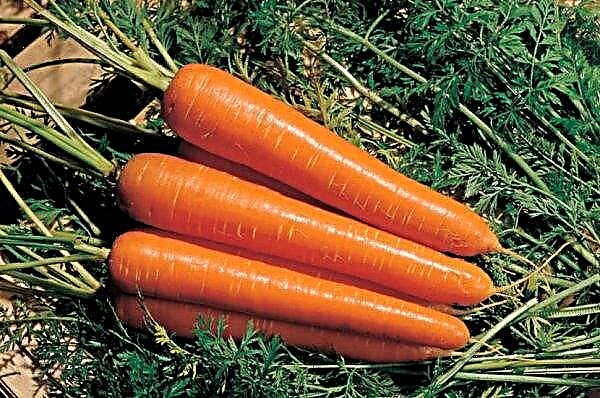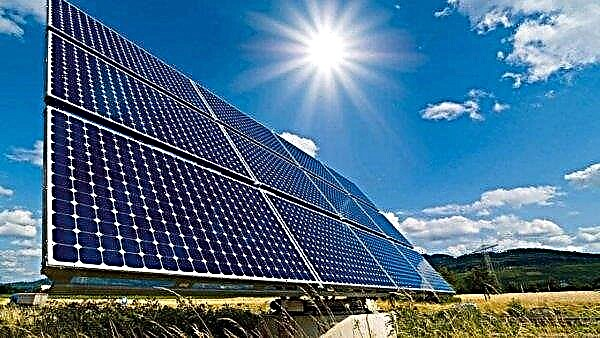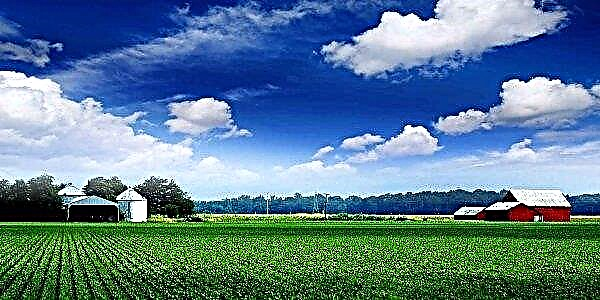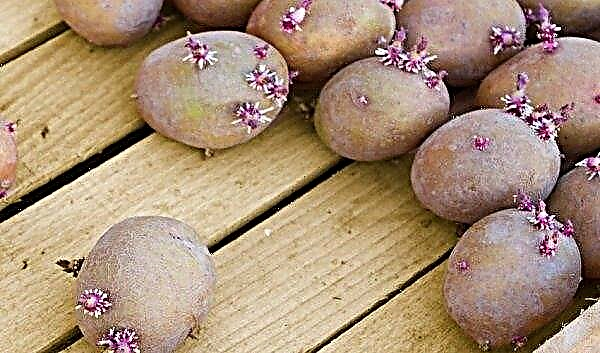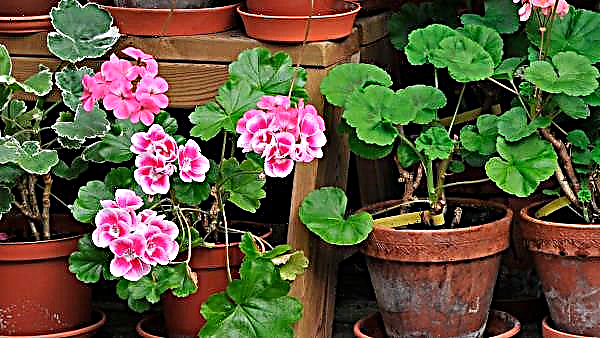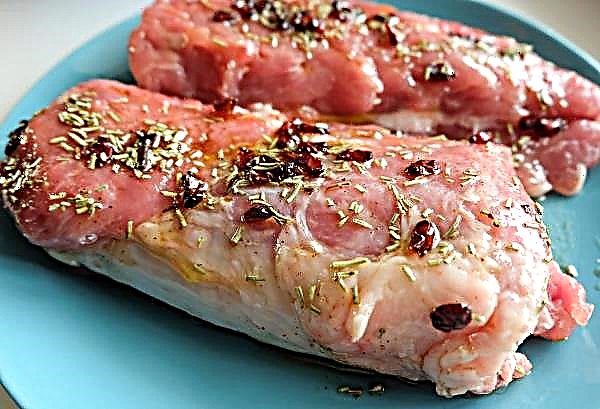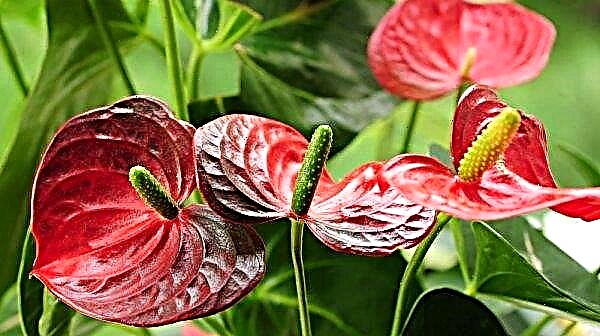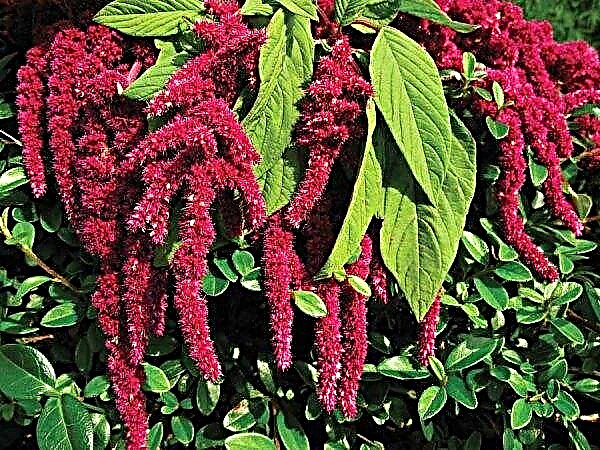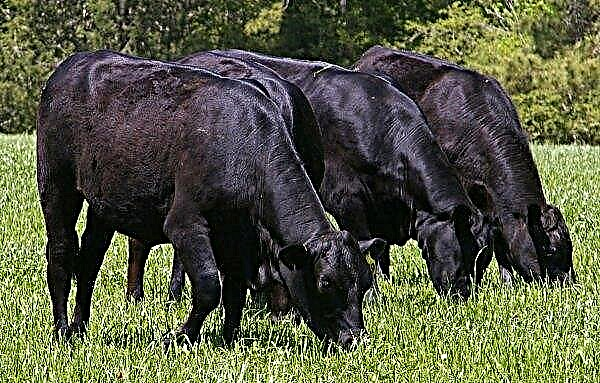Red powder with a sweet taste called paprika is one of the most popular seasonings in the world. We learn what it is, its composition, usefulness and possible harm, how it can be used and how it differs from red pepper.
What is paprika?
This seasoning is always sold ground and has a bright red color. The basis for it are certain varieties of vegetable pepper with a sweet or slightly burning taste, densely colored in red. The fruits are dried and ground into powder. Its severity largely depends on the number of seeds and septa containing capsaicin taken for it. It is this alkaloid that makes cayenne hot.
Did you know? There is a Scovilla scale, on the basis of which the burning ability of peppers is determined by the content of capsaicin in them. Paprika’s hotness ranges from 0 to 1000 units on it, which, as it grows, can be characterized as neutral, soft and warm hotness.
In a spice made of bell pepper, the burning will be 0. The varieties of red capsicum going to this seasoning are grown mostly in Hungary, the United States, Spain, and Turkey. Hungarians divide the spice into 7 types, which consist of different varieties. They vary in taste from sweet mild to searing pungency, their color varies from light red tones to reddish-brownish hues.
Chemical composition
100 g of paprika powder contains the following substances:
- proteins - 14.14 g;
- fats - 12.89 g;
- carbohydrates - 53.99 g;
- water - 11.24;
- ash - 7.74 g.
Vitamins:
- A - 2.46 mg;
- alpha-carotene - 0.595 mg;
- beta-carotene - 26.162 mg;
- beta-cryptoxanthin - 6.19 mg;
- lutein and zeaxanthin - 18.944 mg;
- B1 - 0.33 mg;
- B2 - 1.23 mg;
- B4 - 51.5 mg;
- B5 - 2.51 mg;
- B6 - 2.14 mg;
- B9 - 49 mg;
- C - 0.9 mg;
- alpha-tocopherol - 29.1 mg;
- beta-tocopherol - 0.35 mg;
- gamma-tocopherol - 3.54 mg;
- delta tocopherol - 0.25 mg;
- K - 80.3 μg;
- PP - 10.06 mg;
- betaine - 7.1 mg.
Important! Paprika fruits need to be collected when they are completely painted in a thick red color. The best and traditional way of drying is on the street, tying peppers into whole garlands. If it is not possible to dry vegetables in the open, you can use an electric dryer.
Minerals:
- potassium - 2280 mg;
- phosphorus - 314 mg;
- calcium - 229 mg;
- magnesium - 178 mg;
- sodium - 68 mg;
- iron - 21.14 mg;
- zinc - 4.33 mg;
- Manganese - 1.59 mg;
- copper - 0.713 mg;
- selenium - 6.3 mcg.
In addition, this powder contains phytosterols in an amount of 175 mg / 100 g.
Benefit and harm
Paprika has such beneficial effects on the human body:
- activates the body's defenses;
- increases potency;
- improves metabolism;
- dilutes blood, is useful for thrombosis;
- helps to increase hemoglobin;
- preserves vision;
- improves digestion;
- stimulates the liver and pancreas;
- gives strength, removes drowsiness;
- helps with flatulence, spasms.
Important! All useful properties and taste in ground paprika are preserved for only six months, then it begins to exhale.
Contraindication to it is individual intolerance. This spice is not recommended to be abused by people with exacerbation of pancreatitis and gastrointestinal tract diseases, with increased acidity, cholecystitis, hepatitis. It is undesirable for arrhythmias, cardiac ischemia, palpitations, epilepsy, nervous excitement. It should also be excluded from pregnant women and when breastfeeding.
Calorie content
100 g of powder contains 282 kcal.
Is red pepper and paprika the same thing?
Red pepper and paprika are varieties of chilli with red peel. Visually, paprika usually has a brighter red color, but the main thing that is the difference between red pepper and paprika is hotness, which is determined by the capsaicin content. Red pepper is more burning, it is also called spicy or chili.
Application features
This red flavoring seasoning is very popular in cooking. It is recommended for overweight people.
In cooking
Spice is a popular component of Hungarian, Mexican, Bulgarian, Spanish, Indian cuisine. However, in other countries it is also used everywhere. Most often it is used in the preparation of sauces, ketchups, meat and fish, sausages, first courses, vegetables (stews, stewed cabbage), stuffed eggs. Paprika is also used in the manufacture of certain types of cheeses. A small amount is added to seafood dishes. It harmonizes wonderfully with other spices (garlic, coriander, black pepper, basil, dill) and is part of such a famous spicy mixture as curry. It gives the food a reddish color and taste. This happens best in a greasy environment. Paprika is always added at the end of cooking, and often it is sprinkled with a ready-made dish. This powder can also be used as a natural food coloring.
It harmonizes wonderfully with other spices (garlic, coriander, black pepper, basil, dill) and is part of such a famous spicy mixture as curry. It gives the food a reddish color and taste. This happens best in a greasy environment. Paprika is always added at the end of cooking, and often it is sprinkled with a ready-made dish. This powder can also be used as a natural food coloring.
Did you know? On average, a resident of Hungary eats 0.5 kg of paprika per year. 0.2 kg of spice per capita is consumed in the Balkans, and 0.1 kg in Germany.
In medicine
For medical purposes, burning varieties are used for anti-cold plasters, in ointments and rubbing against radiculitis, rheumatism and joint diseases, with bedsores. Outwardly, it is useful for baldness and brittle nails. Ingesting seasoning stimulates appetite.
When losing weight
Paprika is often used to reduce excess weight. It activates the metabolic and digestive processes, and also contributes to the burning of fat. Of course, it is not used in its pure form, but as an additive in food and drinks, since it improves the fresh taste of dietary food. Now on sale you can find plasters using this spice, as well as tablets with it. Essential oil or extract is very popular for fighting cellulite. These components enhance the blood circulation in places of fat deposits. To combat cellulite and tighten the skin simply use wraps with paprika. Such procedures remove excess fluid well and burn body fat.
Now on sale you can find plasters using this spice, as well as tablets with it. Essential oil or extract is very popular for fighting cellulite. These components enhance the blood circulation in places of fat deposits. To combat cellulite and tighten the skin simply use wraps with paprika. Such procedures remove excess fluid well and burn body fat.
Did you know? Paprika came to Hungary during the Turkish invasions. Now it is so popular there that its museum is opened in the city of Kalochi, and in the other Hungarian city of Szeged there is a museum of salami and paprika.
Growing Features
Paprika is a type of vegetable pepper and is grown, respectively, in the same way:
- Paprika can be planted immediately in open ground only in the southern regions with a warm climate. In other cases, seedlings should first be grown. Seeds for seedlings are planted from late February to the first half of March.
- Seeds for planting should not lie more than 4 years. Before planting, to prevent the appearance of diseases, the seeds must undergo a disinfection process.
- Water the seedlings with warm water and be sure to provide good lighting. With a lack of light in the cold period, you need to turn on artificial lighting.
- Observe crop rotation. It is not necessary to plant a plant for 3 years on a site where solanaceous crops grew earlier.
- When the seedlings reach a height of about 20 cm, and the soil warms up to a temperature of at least + 15 ° C (usually this is mid-May), seedlings can be planted in the ground. The distance between plants during planting should be about 35-40 cm.
- It is necessary to regularly water the watering, loosen and mulch the soil, carry out at least 3 top dressings (before flowering, during flowering, the formation of the ovary and fruiting). During the flowering period, to increase productivity, it is necessary to do foliar top dressing (with ash and boric acid).
- It is also necessary to carry out preventive spraying from diseases and pests. At the first sign of a disease or pest, take appropriate measures.
- When growing pepper on scarce soils, organic fertilizers should be applied - manure, bird droppings, ash, humus.
 Paprika helps to improve the taste of various dishes, has a mild taste, and can be used simply as a dye for food. When using it, you need to remember that it brings great benefits to the human body, but it also has contraindications.
Paprika helps to improve the taste of various dishes, has a mild taste, and can be used simply as a dye for food. When using it, you need to remember that it brings great benefits to the human body, but it also has contraindications.


